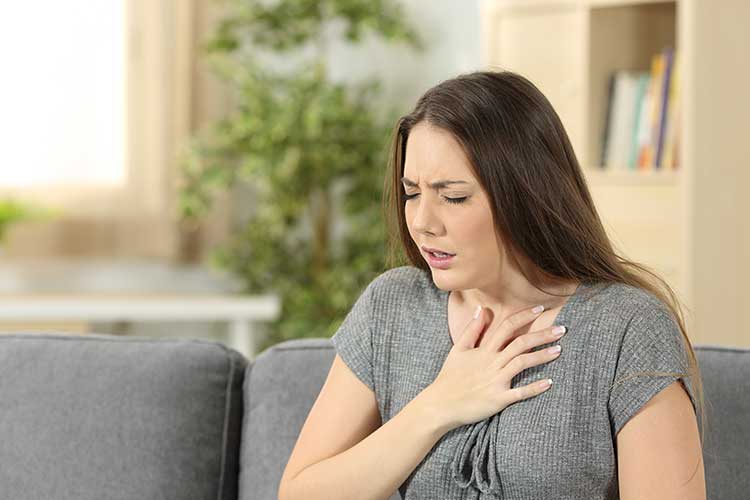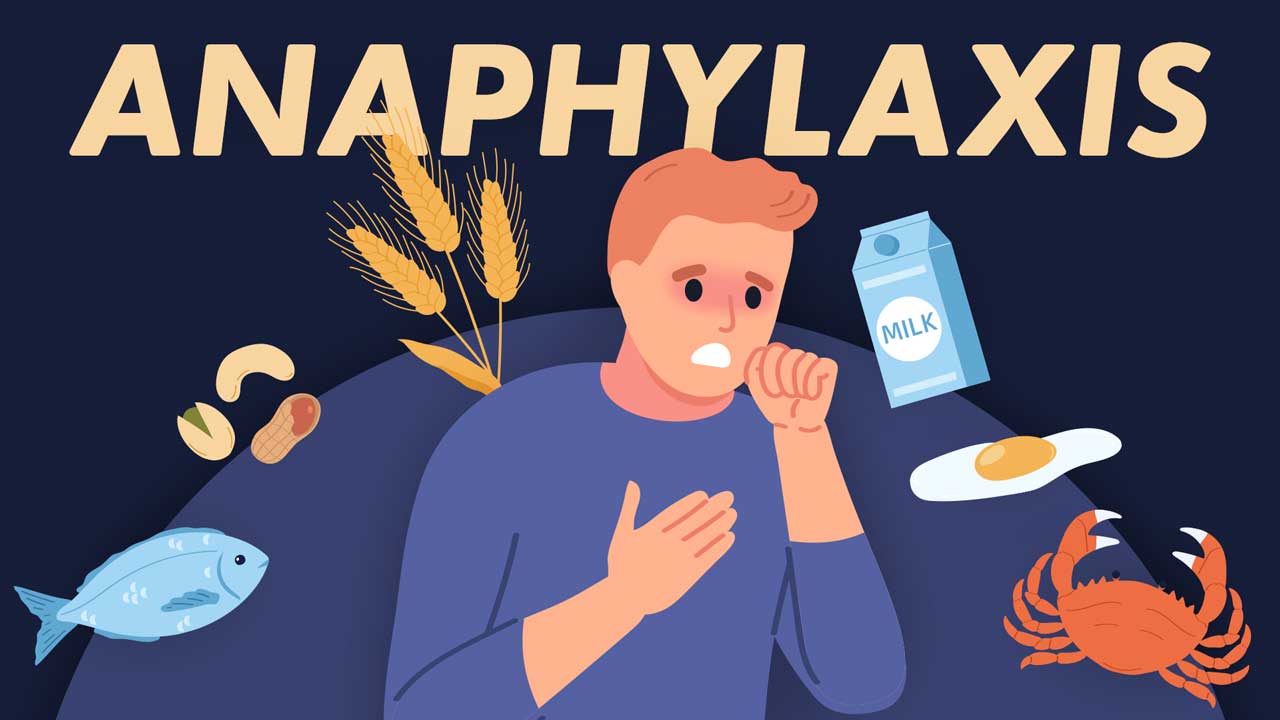Over four million Australians (one in five) are affected by allergic diseases. Allergic diseases include anaphylaxis, allergic rhinitis, asthma, eczema and others (Parliament of Australia 2020).
Anaphylaxis is the most severe type of allergic reaction. It is a potentially life-threatening medical emergency that requires urgent treatment (Allergy & Anaphylaxis Australia 2021).
Anaphylaxis accounts for about 20 deaths and 2,400 hospital admissions every year in Australia (National Allergy Council 2021). Over the past 20 years, hospital admissions for anaphylaxis have increased five-fold (Better Health Channel 2023)
Despite this, anaphylaxis is preventable (Allergy & Anaphylaxis Australia 2021).
What is Anaphylaxis?
Anaphylaxis is a severe generalised allergic reaction. Symptoms generally occur within 20 minutes to 2 hours after exposure to the allergen and may quickly escalate, with the potential to become life-threatening (Allergy & Anaphylaxis Australia 2021).
Note that not every person with an allergy will experience anaphylaxis (ASCIA 2021a).
The Australian Society of Clinical Immunology and Allergy (ASCIA) defines anaphylaxis as:
- ‘Any acute onset illness with typical skin features (urticarial rash or erythema/flushing, and/or angioedema), plus involvement of:
- Respiratory and/or
- Cardiovascular and/or
- Persistent severe gastrointestinal symptoms; OR
- Any acute onset of hypotension or bronchospasm or upper airway obstruction where anaphylaxis is considered possible, even if typical skin features are not present.’
(ASCIA 2023)
Anaphylaxis Signs and Symptoms

The following symptoms suggest a mild to moderate allergic reaction. Note that these symptoms may precede anaphylaxis.
- Swelling of the face, lips or eyes
- Rash, hives or welts
- Tingling mouth
- Abdominal pain and vomiting (which may indicate anaphylaxis caused by an insect allergy)
- Localised swelling at a sting site (in the case of an insect sting)
- Changes to the skin and mucosa.
(ASCIA 2023; ACSQHC 2021)
Anaphylaxis includes one or more of the following potentially life-threatening symptoms:
- Difficult or noisy breathing
- Swelling of the tongue
- Tightness or swelling in the throat
- Difficulty speaking and/or a hoarse voice
- A wheeze or persistent cough (usually with a sudden onset)
- Persistent dizziness or collapse
- Pallor and floppiness (in pediatrics)
- Abdominal pain and vomiting (which may indicate anaphylaxis caused by an insect allergy or injected drug allergy).
(ASCIA 2023)
Note that in up to 20% of anaphylactic reactions, skin and mucosal changes are minor or completely absent (ACSQHC 2021a).
The severity of an anaphylactic reaction may be influenced by:
- Exercise
- Heat
- Alcohol
- Amount of food eaten and how it was prepared (in anaphylaxis caused by food).
(ASCIA 2021a)
Causes of Anaphylaxis
Anaphylaxis is most likely to be triggered by foods, medicines, or insect stings (ASCIA 2023).
The onset of symptoms may depend on the allergen triggering the reaction.
- Reactions caused by food usually occur within one to two hours of ingestion but can occur within 30 minutes or even several hours later
- Reactions caused by stings or injected medicines usually occur within 5 to 30 minutes.
(ASCIA 2023)
About 10% of infants, 4 to 8% of children, and 2% of adults experience food allergies. Although any food can cause an allergic reaction, 90% of reactions are triggered by:
- Cow's milk
- Eggs
- Peanuts
- Tree nuts
- Sesame
- Soy
- Fish
- Shellfish
- Wheat.
(ASCIA 2021b)

Medicine-related anaphylaxis is most commonly caused by:
- Antibiotics
- Non-steroidal anti-inflammatory drugs (NSAIDs)
- Contrast-induced anaphylactoid reactions
- Immunotherapy.
(Nickson 2023)
Insect sting-related anaphylaxis is most commonly caused by honeybees, wasps, or ants (Nickson 2020).
In more than 50% of cases, the trigger for anaphylaxis cannot be identified (Nickson 2020).
Less common causes of anaphylaxis include:
- Physical triggers such as exercise, heat, cold, or ultraviolet light
- Biological fluids such as transfusions, immunoglobulin, antivenoms and semen
- Latex rubber
- Tick bites
- Hormonal changes such as breastfeeding or menstruation
- Dialysis membranes
- Hydatid cyst rupture
- Aeroallergens (animals and pollen)
- Food additives such as preservatives and colors
- Topic medications such as antiseptics
(Nickson 2023)
Those most likely to be allergic to latex are people who are frequently exposed to it, such as healthcare workers (ASCIA 2019).
Diagnosing Anaphylaxis
Immunoglobulin E (IgE) are antibodies produced by the immune system. If you have an allergy, your immune system overreacts to an allergen by producing IgE (ASCIA 2020).
Diagnosis involves testing for raised antibodies in response to a particular allergen that is given. This can be performed through tests such as:
- Full blood count with differential
- Eosinophil count
- Total serum immunoglobulin levels
- Skin tests
- Challenge tests
- Radio-Allergo-Sorbent Test (RAST).
(ASCIA 2020)
One of the difficulties with recognizing an anaphylactic reaction is that there are many differential diagnoses. Some of these include:
- Acute oesophageal reflux
- Alcohol-related flushing
- Asthma
- Dystonic reactions that mimic swollen tongue
- Epileptic seizures
- Globus hystericus
- Idiopathic urticaria
- Isolated angioedema
- Laryngospasm
- Panic disorders
- Peptide-secreting tumours
- Pheochromocytoma
- Scombroid fish poisoning
- Serum sickness
- Shock
- Stroke
- Systemic inflammatory response syndrome
- Systemic mastocytosis.
- Vasovagal syncope
- Vocal cord dysfunction.
(Nickson 2023)
Treatment of an Anaphylactic Reaction
For the most up-to-date guidelines for immediate treatment and management of anaphylactic reactions, refer to ASCIA’s Guidelines - Acute Management of Anaphylaxis.
What is Adrenaline?
Adrenaline (epinephrine) is the first-line treatment of anaphylaxis. It is the only treatment that decreases the amplification of an allergic response. Adrenaline reduces hospitalization and death from anaphylaxis (ACSQHC 2021). It works by:
- Reducing airway mucosal edema
- Inducing bronchodilation
- Inducing vasoconstriction
- Increasing the strength of cardiac contraction.
(ASCIA 2023)
Adrenaline also has a relatively short half-life (plasma half-life of approximately two to three minutes). Some patients may experience adverse effects such as transient pallor, palpitations, or headaches after administration (EMC 2023).
Monitoring the Patient After an Anaphylactic Reaction
The patient should not be allowed to stand or walk until they are hemodynamically stable.
- Patients who received one dose of adrenaline should wait for at least one hour before standing or walking
- Patients who received more than one dose of adrenaline should wait for at least four hours before standing or walking.
(ASCIA 2023)
The patient should be closely monitored (increase the frequency of observations) for at least 4 hours following their last dose of adrenaline, as there is potential for relapse. Increase the frequency of overnight observations or consider critical care if the patient is hemodynamically unstable. Overnight observation is recommended if the patient:
- Experienced a severe or protracted (e.g. repeated doses of adrenaline or IV fluid resuscitation) reaction
- Has a history of severe or protracted anaphylaxis
- Has a concomitant illness such as asthma or arrhythmia
- Lives alone or remotely from medical care
- Presented for care late in the evening.
(ASCIA 2023)
Any person with anaphylaxis should have an anaphylaxis management plan. Training and education, as well as an emergency kit containing medication such as adrenaline, should be provided to the patient and their family (ACSQHC 2021).
The Acute Anaphylaxis Clinical Care Standard
The Acute Anaphylaxis Clinical Care Standard was released by the Australian Commission on Safety and Quality in Health Care in 2021.
This standard aims to improve the recognition, treatment and follow-up care of anaphylaxis (ACSQHC 2021).
The standard comprises the following six Quality Statements:
| Quality Statement 1: Prompt recognition of anaphylaxis | Patients displaying the symptoms of anaphylaxis should be assessed rapidly, especially if they have a history of allergy or have been exposed to an allergic trigger. |
| Quality Statement 2: Immediate injection of intramuscular adrenaline | Adrenaline should be administered without delay if a patient is having an anaphylactic reaction or suspected anaphylactic reaction. Adrenaline must be administered before any other treatment, including asthma medicine, corticosteroids and antihistamines. |
| Quality Statement 3: Correct patient positioning | Patients experiencing an anaphylactic reaction should be laid flat. They can sit with their legs extended if they are having difficulty breathing. Patients are not permitted to stand or walk until they have been assessed as safe to do so. |
| Quality Statement 4: Access to a personal adrenaline injector in all healthcare settings | Patients should have access to their own adrenaline injectors at all times when receiving care and can self-medicate if required. |
| Quality Statement 5: Observation time following anaphylaxis | Patients who have experienced an anaphylactic reaction should be monitored for at least four hours following their last dose of adrenaline. In accordance with ASCIA’s Acute Management of Anaphylaxis Guidelines, overnight observation may be required. |
| Quality Statement 6: Discharge management | Prior to discharge from a healthcare facility, patients should receive:
|
(ACSQHC 2021)
Test Your Knowledge
Question 1 of 3
A patient is experiencing an anaphylactic reaction. Which one of the following treatments should be given first?
Topics
References
- Allergy & Anaphylaxis Australia 2021, What is Anaphylaxis?, Allergy & Anaphylaxis Australia, viewed 25 January 2024, https://allergyfacts.org.au/allergy-anaphylaxis/what-is-anaphylaxis
- Australian Commission on Safety and Quality in Health Care 2021, Acute Anaphylaxis Clinical Care Standard, Australian Government, viewed 25 January 2024, https://www.safetyandquality.gov.au/publications-and-resources/resource-library/acute-anaphylaxis-clinical-care-standard-2021
- Australian Society of Clinical Immunology and Allergy 2023, ASCIA Guidelines - Acute Management of Anaphylaxis, ASCIA, viewed 25 January 2024, https://www.allergy.org.au/hp/papers/acute-management-of-anaphylaxis-guidelines
- Australian Society of Clinical Immunology and Allergy 2020, Laboratory Investigation of Allergic Diseases, ASCIA, viewed 25 January 2024, https://www.allergy.org.au/hp/papers/tests-in-the-diagnosis-of-allergic-diseases
- Australian Society of Clinical Immunology and Allergy 2021a, Anaphylaxis, ASCIA, viewed 25 January 2024, https://www.allergy.org.au/patients/about-allergy/anaphylaxis
- Australian Society of Clinical Immunology and Allergy 2021b, Food Allergy, viewed 25 January 2024, https://www.allergy.org.au/patients/food-allergy/food-allergy
- Australian Society of Clinical Immunology and Allergy 2019, Latex Allergy, ASCIA, viewed 25 January 2024, https://www.allergy.org.au/patients/other-allergy/latex-allergy
- Better Health Channel 2023, Anaphylaxis, Victoria State Government, viewed 25 January 2024, https://www.betterhealth.vic.gov.au/health/conditionsandtreatments/anaphylaxis
- Electronic Medicines Compendium 2023, Adrenaline (Epinephrine) Injection BP 1 in 1000, Electronic Medicines Compendium, viewed 25 January 2024, https://www.medicines.org.uk/emc/product/6284/
- National Allergy Council 2021, Surviving a Severe Allergic Reaction: Three of the Most Dangerous Mistakes, National Allergy Council, viewed 25 January 2024, https://nationalallergycouncil.org.au/news/media-releases/surviving-a-severe-allergic-reaction-three-of-the-most-dangerous-mistakes
- Nickson, C 2023, Anaphylaxis DDx, Life in the Fast Lane, viewed 25 January 2024, https://litfl.com/anaphylaxis-ddx/
- Parliament of Australia 2020, ‘2. Overview of Allergies and Anaphylaxis in Australia’, Walking the Allergy Tightrope, Commonwealth of Australia, viewed 25 January 2024, https://www.aph.gov.au/Parliamentary_Business/Committees/House/Health_Aged_Care_and_Sport/Allergiesandanaphylaxis/Report/section?id=committees%2freportrep%2f024422%2f72559
 New
New 
